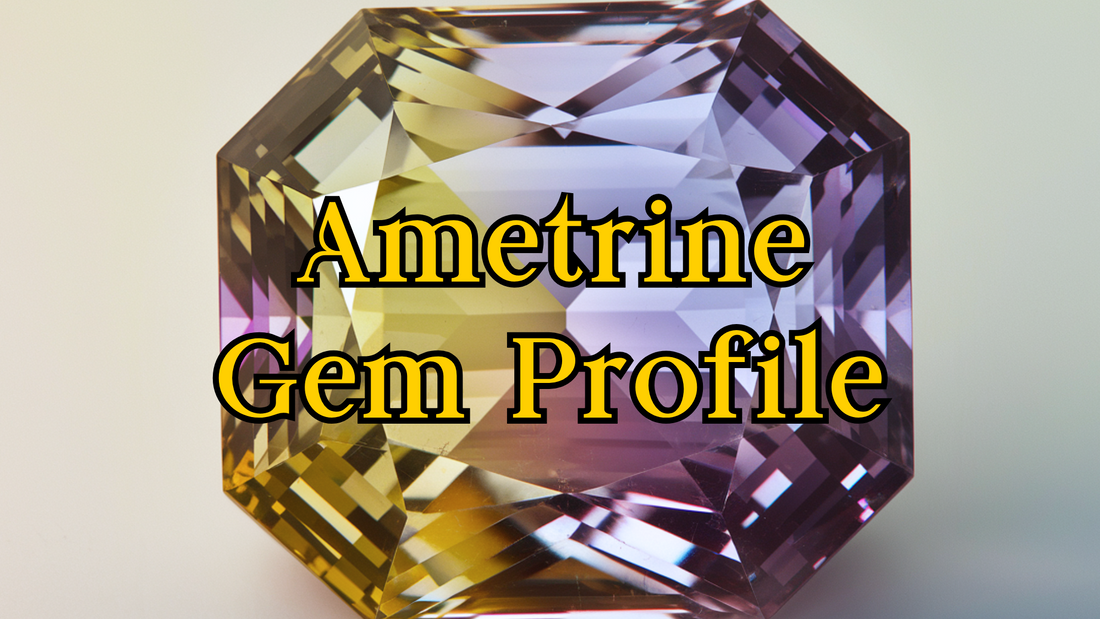
A Jeweller’s Guide to Ametrine: Identification Tips and Jewellery Making Advice
Step into the magical world of ametrine, a gemstone that’s basically nature’s version of a sunset in crystal form. With its mesmerising blend of golden citrine and royal-purple amethyst, ametrine is the ultimate two-for-one deal. Perfect for jewellers looking to add a splash of intrigue to their designs, this bi-colour beauty is as rare as it is captivating.
In this guide, we’ll explore everything you need to know about ametrine, from its unique formation to how to make it the star of your next jewellery piece. Ready to fall under its spell? Let’s dive in!
 Basic Identification Information
Basic Identification Information
- Name & Synonyms: Ametrine; also known as "bolivianite" (after its primary source, Bolivia).
- Species: Quartz
- Colour Range: Colour zones of purple (amethyst) and yellow-to-orange (citrine). The blend is often sharp and dramatic, but softer gradations can also occur.
- Refractive Index: 1.544–1.553
- Birefringence: 0.009
- Optical Sign: Uniaxial+
- Specific Gravity: 2.65
- Fluorescence: Inert to Weak.
- Lustre: Vitreous (glass-like shine when polished).
- Clarity: Type 2 – usually included, although it's not unusual to find eye clean examples.
- Gems often mistaken for ametrine: Bi-colour tourmaline, fluorite, or synthetic stones.
- Mohs Hardness: 7
- Wearability: Good for most jewellery types but susceptible to scratches over time.
- Birthstone: Not officially a birthstone but can be used in place of amethyst (February) or citrine (November).
 Common Treatments
Common Treatments
Most ametrine on the market is untreated, and its gorgeous natural bi-colour is a result of unique geological conditions. However, some ametrines are created artificially by heat-treating or irradiating amethyst to introduce citrine zones. Synthetic ametrine is also available, often produced in laboratories through hydrothermal processes.
 Durability Considerations
Durability Considerations
Ametrine is a hardy gem, but like all quartz, it’s not indestructible. Its Mohs hardness of 7 means it can resist daily wear, but it’s prone to scratches if not handled carefully. Prolonged exposure to strong sunlight can cause its vibrant colours to fade, so remind your customers to keep it away from sunbathing sessions.
 Jeweller's Setting Tips
Jeweller's Setting Tips
The beauty of ametrine lies in its striking bi-colour effect, so maximise this by orienting the stone in a way that highlights the colour split. Fancy cuts like emerald, cushion, or rectangular shapes work wonderfully to showcase the distinct zones of purple and yellow. Protective settings like bezels or low-profile prongs are great options for rings to ensure long-term wearability.
Want to cast in place? Don't! High heat isn’t friendly to ametrine, and you don’t want to risk altering its stunning colours. Taking these precautions ensures that your jewellery maintains the gem’s natural beauty without compromise.
 Care Instructions
Care Instructions
Caring for ametrine is simple: use warm, soapy water and a soft brush to keep it sparkling. Avoid steam or ultrasonic cleaners, as they could damage the stone. Store it separately from harder gems like sapphire or diamond to prevent scratches. A little TLC goes a long way in preserving its captivating hues!
 Aesthetic & Design Insights
Aesthetic & Design Insights
Ametrine is the perfect choice for jewellery that’s bold, unique, and a little playful. Its dual colours work beautifully in both statement pieces and minimalistic designs, depending on how you set it. Pair ametrine with yellow gold to bring out the warmth of its citrine half or with white metals like silver or platinum for a sleek, modern contrast.
For added drama, surround it with accent stones like diamonds, white sapphires, or purple garnets to play up its luxurious vibe. This combination enhances its stunning colour play and makes it an eye-catching centrepiece. Whether in rings, pendants, or earrings, ametrine offers endless design possibilities.
 Market & Ethical Notes
Market & Ethical Notes
Ametrine is relatively rare, with the majority of natural stones originating from the Anahí mine in Bolivia. This makes it an excellent conversation starter for jewellery enthusiasts. Thanks to its limited sources, ethical sourcing is easier to verify, but always work with trusted suppliers to ensure your stones align with sustainable practices. Synthetic ametrine offers a more affordable and eco-friendly alternative for those on a budget.
 Metaphysical Properties
Metaphysical Properties
Ametrine is the ultimate balance stone, blending the uplifting energy of citrine with the calming vibes of amethyst. It’s thought to promote harmony, clarity, and creative problem-solving—perfect for those days when your design ideas just aren’t coming together.
Want to read more about amertines properties? Click Here
 Fun Fact
Fun Fact
Did you know that ametrine is one of the few gems in the world that forms naturally as a combination of two colours? This unique phenomenon occurs due to temperature differences during the stone’s formation, which cause different zones to crystallise as amethyst or citrine.
Interested in more ametrine facts? Click Here
